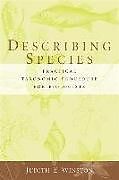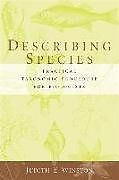Describing Species
Einband:
Kartonierter Einband
EAN:
9780231068253
Untertitel:
Practical Taxonomic Procedure for Biologists
Genre:
Biologie
Autor:
Judith Winston
Herausgeber:
Columbia University Press
Anzahl Seiten:
512
Erscheinungsdatum:
04.11.1999
ISBN:
978-0-231-06825-3
Autorentext
Judith Winston
Klappentext
New species are discovered every day -- and cataloguing all of them has grown into a nearly insurmountable task world-wide. Now, this definitive reference manual acts as a style guide for writing and filing species descriptions. New collecting techniques and new technology have led to a dramatic increase in the number of species that are discovered. Explorations of unstudied regions and new habitats for almost any group of organisms can result in a large number of new species discoveries -- and hence the need to be described. Yet there is no one source a student or researcher can readily consult to learn the basic practical aspects of taxonomic procedures. Species description can present a variety of difficulties: Problems arise when new species are not given names because their discoverers do not know how to write a formal species description or when these species are poorly described. Biologists may also have to deal with nomenclatural problems created by previous workers or resulting from new information generated by their own research. This practical resource for scientists and students contains instructions and examples showing how to describe newly discovered species in both the animal and plant kingdoms.With special chapters on publishing taxonomic papers and on ecology in species description, as well as sections covering subspecies, genus-level, and higher taxa descriptions, Describing Species enhances any writer's taxonomic projects, reports, checklists, floras, faunal surveys, revisions, monographs, or guides. The volume is based on current versions of the International Codes of Zoological and Botanical Nomenclature and recognizes that systematics is a global and multicultural exercise. Though Describing Species has been written for an English-speaking audience, it is useful anywhere Taxonomy is spoken and will be a valuable tool for professionals and students in zoology, botany, ecology, paleontology, and other fields of biology.
Zusammenfassung
A basic practical manual for the process of describing new species, this desperately needed desk reference and guide to nomenclatural procedure and taxonomic writing serves as a Strunk & White of species description, covering both botanical and zoological codes of nomenclature.
Inhalt
I. Introduction Describing the Living World Why Is Species Description Necessary? How New Species Are Described Scope and Organization of This Book The Pleasures of Systematics Sources 2. Biological Nomenclature Humans as Taxonomists Biological Nomenclature Folk Taxonomy Binomial Nomenclature Development of Codes of Nomenclature The Current Codes of Nomenclature Future of the Codes Sources II. Recognizing Species 3. Species and Their Discovery Species Concepts Processes Affecting Speciation Taxonomic Characters Examples of Ways in Which Biologists Have Discovered New Species Sources 4. Establishing Identity: The Literature Search Mistakes and Bad Examples Establishing Identity Where to Find the Taxonomic Literature How to Read the Taxonomic Literature Species Descriptions Taxonomic Literature Searching on the Internet Sources 5. Establishing Identity: Using Museum Collections Collections, Museums, and Herbaria Locating Material Borrowing Material Type Material Visiting Collections: What to Expect and How to Behave Cooperation with Systematists Sources III. Writing Species Descriptions 6. Species Descriptions in Taxonomy Reasons for Writing Species Descriptions Different Kinds of Taxonomic Publications Form of the Descriptive Paper 7. Headings and Synonymies Description Headings Synonyms Synonymies New Species Types of Synonymies Terms Used in Synonymies Different Kinds of Synonymies References in Headings and Synonymies 8. Naming Species: Etymology Brief Review of Latin and Greek Basic Rules of Species Names Descriptive Species Names Geographic Species Names Commemorative Species Names Nonsense Species Names The Etymology Section Sources 9. Type and Voucher Material Rationale for Types and Vouchers Rules of Nomenclature Regarding Types Selection of Types and Vouchers Composition of Type Material Documentation of Type Material Deposition of Types Type Section Sources 10. Diagnosis What Is a Diagnosis? Diagnosis in Zoological Taxonomy Diagnosis in Botanical Taxonomy What Is a Diagnostic Character? The Diagnosis Section: Animals The Diagnosis Section: Plants Additional Uses for Diagnoses 11. Description Section Descriptive Writing Information Used in the Description Section Writing the Description Telegraphic Style The Description Section: Animals (Examples of Style for Different Groups) The Description Section: Plants (Examples of Style for Different Groups) Illustrating Taxonomic Descriptions Sources 12. Taxonomic Discussion Section Purpose of the Discussion Section Discussion in Descriptions of New Species Evidence to Include Composite Papers The Discussion Section in Other Species Descriptions Taxonomic Ethics 13. The Ecology Section Ecology in Species Descriptions Analysis of Ecological Variation Field Records: Getting the Most from Field Work Ecological Information from Museum Specimens The Ecology Section Sources 14. Occurrence and Distribution Distributional Information in Species Descriptions Parameters of Species Distributions The Distribution Section Distribution Papers Sources 15. Material Examined Practical Value In Original Description In Other Descriptions Material Examined Section Material Examined: Botanical Taxonomy The Material Examined Paper Sources 16. Publication Criteria of Publication: Zoology Criteria of Publication: Botany Preparation of the Manuscript Submission of the Manuscript Final Revision and Publication Journals That Publish Taxonomic Papers IV. Beyond Species Description 17. Subspecies Why Are Subspecies Important? Infraspecific Variation Rules of Infraspecific Nomenclature: Zoology Rules of Infraspecific Nomenclature: Botany Deciding When to Name an Infraspecific Taxon Writing Infraspecific Descriptions Sources 18. Genus-Level Description and Revision The Genus Concept When to Describe a New Genus Generic Names Publication of Generic Names Generic Types Examples of Generic-Level Description Problems Caused by Generic Revision Infrageneric Categories and Names Sources 19. Keys Keys in Taxonomy Key Characters Single-Access (Analytical or Sequential) Keys Multiaccess Keys (Polyclaves) Interactive Identification Key Construction Computerized Key Construction Sources 20. Description of Higher Taxa Family Concepts and Their Use in Taxonomy Practical Significance in Biology Describing Families Family-Level Descriptions: Examples Redescriptions of Family-Level Taxa Descriptions of Taxa Above the Family Level Problems with Nomenclature of Higher Taxa Sources 21. Common Problems Missing Types Lectotypes Neotypes Necessary Name Changes Replacement Names: Homonymy Conservation of a Name Emendations New Combinations Lack of Information 22. Further Studies in Systematics Evolutionary Systematics Phenetics Cladistics Molecular Systematics Biogeography Comparative Biology Sources Literature Cited

Leider konnten wir für diesen Artikel keine Preise ermitteln ...
billigbuch.ch sucht jetzt für Sie die besten Angebote ...
Die aktuellen Verkaufspreise von 6 Onlineshops werden in Realtime abgefragt.
Sie können das gewünschte Produkt anschliessend direkt beim Anbieter Ihrer Wahl bestellen.
Loading...
Die aktuellen Verkaufspreise von 6 Onlineshops werden in Realtime abgefragt.
Sie können das gewünschte Produkt anschliessend direkt beim Anbieter Ihrer Wahl bestellen.
| # | Onlineshop | Preis CHF | Versand CHF | Total CHF | ||
|---|---|---|---|---|---|---|
| 1 | Seller | 0.00 | 0.00 | 0.00 |
